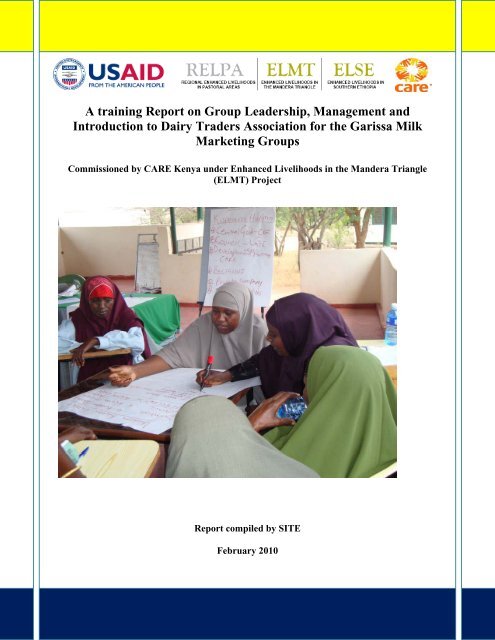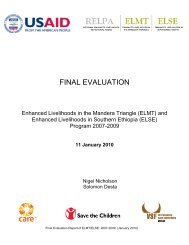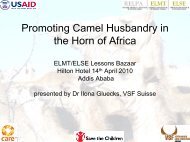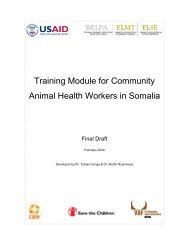A training Report on Group Leadership, Management and ...
A training Report on Group Leadership, Management and ...
A training Report on Group Leadership, Management and ...
You also want an ePaper? Increase the reach of your titles
YUMPU automatically turns print PDFs into web optimized ePapers that Google loves.
A <str<strong>on</strong>g>training</str<strong>on</strong>g> <str<strong>on</strong>g>Report</str<strong>on</strong>g> <strong>on</strong> <strong>Group</strong> <strong>Leadership</strong>, <strong>Management</strong> <strong>and</strong>Introducti<strong>on</strong> to Dairy Traders Associati<strong>on</strong> for the Garissa MilkMarketing <strong>Group</strong>sCommissi<strong>on</strong>ed by CARE Kenya under Enhanced Livelihoods in the M<strong>and</strong>era Triangle(ELMT) Project<str<strong>on</strong>g>Report</str<strong>on</strong>g> compiled by SITEFebruary 2010
Table of C<strong>on</strong>tentsPage NumberExecutive Summary 2Introducti<strong>on</strong> 3Course Outline 4Training activities <strong>and</strong> recommendati<strong>on</strong>s 7Recommendati<strong>on</strong>s <strong>and</strong> c<strong>on</strong>clusi<strong>on</strong>s 12Annexes 131
Executive summaryThe small-scale individual entrepreneur can c<strong>on</strong>tribute significantly towards the competitivenessof their respective sub-sectors but <strong>on</strong>ly if they are organized into groups <strong>and</strong> their respectivecapacities strengthened. Only then can they approach markets <strong>and</strong> instituti<strong>on</strong>s collectively aswell as be able to advocate <strong>and</strong> lobby for change within the sectors in which they operate. This isespecially critical am<strong>on</strong>g small-scale dairy traders <strong>and</strong> producers who currently do not have anaudible voice within the dairy/milk value chain.In November 2009, SITE partnered with CARE Kenya in an assignment aimed at helping camelmilk marketing groups improve milk quality <strong>and</strong> explore better marketing channels for camelmilk. In the assignment, we found that the milk marketing groups in Garissa were in clusters thatneeded to be strengthened in leadership <strong>and</strong> management aspects. The groups also expressedneed to link up to the Nati<strong>on</strong>al Dairy Traders Associati<strong>on</strong> (DTA), an associati<strong>on</strong> formed throughSITE’s initiative towards improving the livelihoods of small-scale milk traders.During the assignment, SITE trainers covered six topics aimed at helping the participants acquireskills in group leadership, group management, provisi<strong>on</strong> of services to group members, businessskills, how to set up <strong>and</strong> run a successful milk bar/canteen as well as introducing the c<strong>on</strong>cept ofself-organizati<strong>on</strong>. The Chairman of nati<strong>on</strong>al DTA gave a talk to the participants detailing thebenefits of associating <strong>and</strong> requirements for membership. SITE used <strong>on</strong>e <str<strong>on</strong>g>training</str<strong>on</strong>g> team of twopeople during the workshop.The <str<strong>on</strong>g>training</str<strong>on</strong>g> took place in Garissa’s Agricultural Training Centre over a period of five days.Garissa is in Kenya’s North Eastern Province <strong>and</strong> borders Somalia to the East. A total of 30leaders were trained in all the outlined topics.Language barrier presented a challenge because even if most of the participants could underst<strong>and</strong>Kiswahili, some could not speak or answer in Kiswahili. However, CARE staff as well as theparticipants helped with the translati<strong>on</strong> whenever necessary.Out of this <str<strong>on</strong>g>training</str<strong>on</strong>g>, it emerged that for the Garissa milk traders to benefit from joint acti<strong>on</strong>, theymust work with other milk traders <strong>and</strong> stakeholders in the dairy sub-sector. This is <strong>on</strong>ly possibleif their individual groups are strengthened in all group aspects. These include: leadership, groupmanagement, business management <strong>and</strong> service provisi<strong>on</strong> to their members. This must also applyto the umbrella bringing the various groups together.Equally important for the milk groups is the strengthening of their members’ businesses throughincreased market access. Establishment of individual or group milk bars is <strong>on</strong>e way of increasingmarket access since it promotes direct milk c<strong>on</strong>sumpti<strong>on</strong>.2
SECTION IIntroducti<strong>on</strong>Care Kenya, al<strong>on</strong>g with the other partners of Enhanced Livelihoods in the M<strong>and</strong>era Triangle(ELMT) Project; have been working with the pastoralist communities in Garissa <strong>and</strong> otherdistricts in the M<strong>and</strong>era Triangle in an effort to enhance their livelihoods. To achieve this, manyinterventi<strong>on</strong>s have been implemented. This <str<strong>on</strong>g>training</str<strong>on</strong>g> <strong>on</strong> group leadership <strong>and</strong> management as wellas introducing the trained groups to the Dairy Traders Associati<strong>on</strong> (DTA) is a follow up to anearlier assignment d<strong>on</strong>e by SITE in November 2009 <strong>on</strong> <str<strong>on</strong>g>training</str<strong>on</strong>g> the camel milk h<strong>and</strong>lers inGarissa <strong>on</strong> hygienic milk harvesting, h<strong>and</strong>ling, storage, transportati<strong>on</strong> as well as basic businessskills as an interventi<strong>on</strong> under ELMT.The targeted participants under this <str<strong>on</strong>g>training</str<strong>on</strong>g> were the leaders in the camel milk marketing groupsin Garissa town. Thirty participants were trained out of which 25 were women (83%) while <strong>on</strong>lyfive (17%) were men. The leaders fell into two categories – leaders of the individual groups <strong>and</strong>leaders of an umbrella of the individual groups. Twenty six participants were leaders ofindividual groups while four were leaders of the umbrella.The main objective of the assignment was to strengthen the leadership <strong>and</strong> management of thegroups. The groups were also to be encouraged to strengthen their umbrella before linking themto the DTA. The chairman of the nati<strong>on</strong>al DTA was to talk to the leaders <strong>on</strong> the benefits ofassociating am<strong>on</strong>g themselves <strong>and</strong> with other milk traders in Kenya.Expected deliverablesi) A <str<strong>on</strong>g>training</str<strong>on</strong>g> report covering the <str<strong>on</strong>g>training</str<strong>on</strong>g> activities <strong>and</strong> recommendati<strong>on</strong>s <strong>on</strong> the wayforward.ii) A debriefing sessi<strong>on</strong> after completi<strong>on</strong> of the assignmentThis report is divided into four parts, each part addressing a specific deliverable as follows:o Course outlineo Training activities <strong>and</strong> recommendati<strong>on</strong>so Recommendati<strong>on</strong>s <strong>and</strong> c<strong>on</strong>clusi<strong>on</strong>so Annexes3
CARE KENYA/SITE FEB 2010Highlights <strong>on</strong> course outlineCourse outline1. <strong>Group</strong> leadershipWho is a leader? Qualities of a good leaderCommunicati<strong>on</strong><strong>Leadership</strong> core valuesPower <strong>and</strong> authorityAccountability <strong>and</strong> transparencyGender <strong>and</strong> leadership2. <strong>Management</strong> of groups<strong>Management</strong> structureRole of office bearersDuties of leaders <strong>and</strong> members<strong>Group</strong> meetings, electi<strong>on</strong>s <strong>and</strong> c<strong>on</strong>flict resoluti<strong>on</strong>3. Business skills4. Service provisi<strong>on</strong> to members5. How to set up a milk bar6. Introducti<strong>on</strong> to the Dairy Traders Associati<strong>on</strong> (DTA)i. Training methodologyParticipatory <str<strong>on</strong>g>training</str<strong>on</strong>g> methods were used with emphasis <strong>on</strong> group discussi<strong>on</strong>s, plenarypresentati<strong>on</strong>s, experience sharing <strong>and</strong> where possible role plays to make the <str<strong>on</strong>g>training</str<strong>on</strong>g> as learnercentered as possible. The <str<strong>on</strong>g>training</str<strong>on</strong>g> was organized from 9.00 am to 3.00 pm to accommodate thetrading schedules of the trainees. The participants were c<strong>on</strong>versant with Kiswahili hence thetrainers used it in their <str<strong>on</strong>g>training</str<strong>on</strong>g> instead of an interpreter.At the end of the <str<strong>on</strong>g>training</str<strong>on</strong>g>, an exit questi<strong>on</strong>naire was administered. The trainees also outlinedpractices they would adopt or change in the leadership <strong>and</strong> management of their milk groupsbased <strong>on</strong> the acquired knowledge <strong>and</strong> skills.ii. Training aidsThe following <str<strong>on</strong>g>training</str<strong>on</strong>g> aids were used:• Flip charts• Marker pens• Note books• Biro Pens• Illustrati<strong>on</strong>s/picturesTraining <str<strong>on</strong>g>Report</str<strong>on</strong>g> under ELMT compiled by SITE6
CARE KENYA/SITE FEB 2010Training activities <strong>and</strong> recommendati<strong>on</strong>sSECTION III1. Training activitiesTraining for the leaders took place in the Garissa’s Agricultural Training Centre (ATC)c<strong>on</strong>ference hall. A <str<strong>on</strong>g>training</str<strong>on</strong>g> attendance form was used to m<strong>on</strong>itor attendance <strong>and</strong> is attached tothis report as Annex I. The <str<strong>on</strong>g>training</str<strong>on</strong>g> took five days as follows:Day One: Introducti<strong>on</strong> to objectives; <strong>Leadership</strong> in <strong>Group</strong>sThe <str<strong>on</strong>g>training</str<strong>on</strong>g> began <strong>on</strong> Feb 15 th 2010 at 9.00 am in the Garissa ATC c<strong>on</strong>ference hall. Twoofficials from CARE Kenya Garissa Office were present. The participants were taken throughthe objectives of the <str<strong>on</strong>g>training</str<strong>on</strong>g>. <strong>Leadership</strong> <str<strong>on</strong>g>training</str<strong>on</strong>g> was the first topic.The module was h<strong>and</strong>led through group discussi<strong>on</strong>s,plenary presentati<strong>on</strong>s <strong>and</strong> discussi<strong>on</strong>s. Thediscussi<strong>on</strong>s were very informing since theparticipants are leaders who were willing to sharetheir experiences in group leadership.A <strong>Group</strong> Discussi<strong>on</strong> <strong>on</strong> <strong>Leadership</strong>/ Photo SITEDuring the discussi<strong>on</strong>s, it emerged that the umbrellawas initially made up of 31 groups. Due to leadershipwrangles, some groups were forced out of theumbrella. Other groups like Sumeya chose to leavethe umbrella out of their group principles.The current umbrella is made up of 18 milk groups out of the initial 31 groups. The main reas<strong>on</strong>sfor the c<strong>on</strong>flict in the umbrella are: financial mismanagement, competiti<strong>on</strong> for leadership <strong>and</strong>clanism.Day Two: <strong>Group</strong> <strong>Management</strong>The participants were introduced to the four elements of group management: leadership,c<strong>on</strong>stituti<strong>on</strong>, meetings <strong>and</strong> group records. The participants went into groups, discussed <strong>and</strong> thenshared at the plenary. It emerged that the leaders were aware of their roles <strong>and</strong> resp<strong>on</strong>sibilities ingroup leadership.During the discussi<strong>on</strong>s, the leaders c<strong>on</strong>firmed that the groups in the umbrella have c<strong>on</strong>stituti<strong>on</strong>s<strong>and</strong> are fully registered by the Social services department. Unfortunately, most of the groups d<strong>on</strong>ot meet as often as required thus weakening them. The same is true for the umbrella.Training <str<strong>on</strong>g>Report</str<strong>on</strong>g> under ELMT compiled by SITE7
CARE KENYA/SITE FEB 2010Electi<strong>on</strong>s are normally d<strong>on</strong>e using the secret ballot. Electi<strong>on</strong>s for the umbrella were due <strong>on</strong> 20 thFeb 2010 <strong>and</strong> the District Gender <strong>and</strong> Social Development Officer for Garissa came to the<str<strong>on</strong>g>training</str<strong>on</strong>g> <strong>on</strong> 19 th Feb to invite all groups for theelecti<strong>on</strong>s. He <strong>and</strong> the DLPO Garissa want arepresentative leadership in the umbrella, to representall the initial 31 milk groups, including Sumeya.The current leaders of the umbrella c<strong>on</strong>firmed thatthey have not been keeping any records since theprevious leadership was kicked out of office <strong>on</strong>e yearago. CARE Garissa office will assist the newleadership to establish the necessary group records.<strong>Group</strong> discussi<strong>on</strong>s <strong>on</strong> group management/PhotoSITEDay Three: Business skills for small-scale milk tradersThe topic was intended to sharpen the business skills of the milk traders as they c<strong>on</strong>duct theirbusinesses.The sessi<strong>on</strong> was also approached through groupdiscussi<strong>on</strong>s, plenary presentati<strong>on</strong>s <strong>and</strong> discussi<strong>on</strong>s.The participants understood what a small-scalebusiness is <strong>and</strong> factors that lead to its success orfailure.Presentati<strong>on</strong> <strong>on</strong> types of businesses/ Photo SITEDay Four: Service provisi<strong>on</strong> to membersThey also discussed <strong>and</strong> appreciated the importanceof product marketing, planning for their businesses,determining the costs in their businesses as well asrecord keeping. They were taken through somebasic milk records that should be kept daily byevery milk trader. These are milk supplier records,milk sales records as well as expense records.The participants were taken through the importance of service provisi<strong>on</strong> to members as a way ofimproving their businesses <strong>and</strong> strengthening thegroups.They sat in groups, discussed <strong>and</strong> presented <strong>on</strong> thekinds of services they currently offer to theirmembers <strong>and</strong> the <strong>on</strong>es they hope to offer in future.They were also able to identify various serviceproviders in Garissa <strong>and</strong> bey<strong>on</strong>d.<strong>Group</strong> discussi<strong>on</strong> <strong>on</strong> service provisi<strong>on</strong>Training <str<strong>on</strong>g>Report</str<strong>on</strong>g> under ELMT compiled by SITE8
CARE KENYA/SITE FEB 2010The services they identified included l<strong>and</strong> for the camel mini dairy, markets outside Garissa forcamel milk <strong>and</strong> more <str<strong>on</strong>g>training</str<strong>on</strong>g> for their members. They c<strong>on</strong>firmed that power outages are verycomm<strong>on</strong> in Garissa hence those traders who will install deep freezers when thy start milk barsmay have to buy generators.They were able to identify several service providers including the government, the local council,private companies especially banks such as First Community <strong>and</strong> Equity bank as well as NGOssuch as CARE Kenya.Day Five: How to set up <strong>and</strong> manage a group milk bar; Introducti<strong>on</strong> to DTAThe participants were taken through the requirements <strong>and</strong> preparati<strong>on</strong>s for the set up of a milkbar. Most of them had visited the milk bars in Nairobi during their exposure visit in November2009. It was therefore easy for them to remember what they saw <strong>and</strong> c<strong>on</strong>tribute to thediscussi<strong>on</strong>s. The trainers had also carried pictures of a milk bar for the benefit of those who didnot participate in the exposure visit.At the end of the discussi<strong>on</strong>, the participantsexpressed their interest to start milk bars. One lady,Shindez Sheikh Noor, is prepared to invest in her ownmilk bar while Sumeya milk traders have premisesfrom where they are making yoghurt for sale.Sumeya milk group receive milk equipment/Photo SITECARE Kenya Garissa team was impressed by thedeterminati<strong>on</strong> of this group <strong>and</strong> d<strong>on</strong>ated some milkequipment to them as motivati<strong>on</strong>. It comprised ofthree 10-litre aluminium cans, three milk measuringpints, two plastic buckets, two milk sieves <strong>and</strong> themilk testing tool kit.On the same day, the participants were introduced to the Dairy Traders Associati<strong>on</strong> (DTA) bythe nati<strong>on</strong>al Chairman, Sammy Chiira. He introduced to them the associati<strong>on</strong>, its head office,branch offices, objectives, values <strong>and</strong> activities ofDTA <strong>and</strong> how to become a member. The participantsthanked the chairman for receiving them warmlywhen they visited the DTA nati<strong>on</strong>al office during theexposure visit.He outlined the benefits of being a DTA member,key being unity of purpose for improved milkbusinesses. He invited the Garissa milk traders to joinDTA Chairman <strong>and</strong> some Garissa umbrella other milk traders in the DTA. The membersleaders/Photo SITEexpressed interest in joining <strong>and</strong> the leaders promisedto spearhead the process after c<strong>on</strong>sulting with the DLPO Garissa.Evaluati<strong>on</strong> of the <str<strong>on</strong>g>training</str<strong>on</strong>g>Training <str<strong>on</strong>g>Report</str<strong>on</strong>g> under ELMT compiled by SITE9
CARE KENYA/SITE FEB 2010A questi<strong>on</strong>naire was administered to the participants at the end of the <str<strong>on</strong>g>training</str<strong>on</strong>g> to obtain feedbackfrom them. A sample of the evaluati<strong>on</strong> questi<strong>on</strong>naire is attached to this report as Annex II. Theanalysis showed that:• Eighty percent (80%) of the participants rated the presentati<strong>on</strong> methods of the trainers asvery good, while 20% rated them good.• All the participants felt the time allocated for the <str<strong>on</strong>g>training</str<strong>on</strong>g> was enough.• Eighty percent (80 %) of the participants felt the <str<strong>on</strong>g>training</str<strong>on</strong>g> covered all the areas that wereimportant to them but 20% suggested we should have visited their individual groups <strong>and</strong>imparted the knowledge <strong>and</strong> skills to all group members.• All the participants rated the <str<strong>on</strong>g>training</str<strong>on</strong>g> as relevant since all were leaders <strong>and</strong> felt they willbe better leaders due to the <str<strong>on</strong>g>training</str<strong>on</strong>g>.• Forty percent (40 %) of the participants rated the <str<strong>on</strong>g>training</str<strong>on</strong>g> <strong>on</strong> the set up of the milk bar asthe most useful because it is unfamiliar in Garissa. They felt it would improve the qualityof milk, increase incomes <strong>and</strong> create job opportunities. Twenty percent (20%) of theparticipants felt the topic <strong>on</strong> management was most useful because it stressed theimportance of keeping accurate group records <strong>and</strong> c<strong>on</strong>ducting proper electi<strong>on</strong>s. Another20% found leadership <str<strong>on</strong>g>training</str<strong>on</strong>g> very useful while the last 20% found all the topics usefulto them.• All the participants promised to put the gained knowledge <strong>and</strong> skills into practiceespecially in leadership, electi<strong>on</strong>s <strong>and</strong> communicati<strong>on</strong> with group members.• Eighty percent (80%) of the participants felt the most important benefit to members ifthey joined DTA was networking which would enable sharing of ideas with other milktraders. Twenty percent (20%) felt they would be more aware of their rights in additi<strong>on</strong> toaccess to other milk markets due to networking.• On general comments, 40 % of the participants found the <str<strong>on</strong>g>training</str<strong>on</strong>g> useful <strong>and</strong> hoped formore in the near future. Twenty percent (20%) said the trainers were good <strong>and</strong>cooperative, 20% felt Garissa milk traders must associate with others or risk being leftbehind while 20 % did not give a general comment.• The Care Kenya, Garissa team expressed satisfacti<strong>on</strong> with the <str<strong>on</strong>g>training</str<strong>on</strong>g> by the SITEtrainers. They requested SITE for <str<strong>on</strong>g>training</str<strong>on</strong>g> reference material for future follow-up <strong>and</strong>strengthening of the groups.Evaluati<strong>on</strong> Highlights• 80 % of the participants rated the <str<strong>on</strong>g>training</str<strong>on</strong>g> methods of SITE trainers as very goodwhile 20 % rated them as good• All participant felt the allocated <str<strong>on</strong>g>training</str<strong>on</strong>g> time was enough• All the milk traders rated the <str<strong>on</strong>g>training</str<strong>on</strong>g> as useful to their milk businesses• Setting up a milk bar was rated the most useful at 40 % while leadership,management <strong>and</strong> all topics scored 20 % rating each• All participants promised to put the acquired knowledge into practice in theleadership of their groups.• 80 % of the participants felt joining the DTA will be good for members so as t<strong>on</strong>etwork <strong>and</strong> exp<strong>and</strong> their businesses.Training <str<strong>on</strong>g>Report</str<strong>on</strong>g> under ELMT compiled by SITE10
CARE KENYA/SITE FEB 2010SECTION IVRecommendati<strong>on</strong>s <strong>and</strong> c<strong>on</strong>clusi<strong>on</strong>sOrganizati<strong>on</strong> of milk traders is important for joint acti<strong>on</strong>. The Garissa Camel milk traders’umbrella has been in existence since 2007. However, it has not d<strong>on</strong>e much for the betterment ofthe milk traders’ businesses due to leadership wrangles that weaken it. If the umbrella is to bestr<strong>on</strong>g for traders’ joint acti<strong>on</strong>, the c<strong>on</strong>stituent groups must be strengthened first.The strength of both the groups <strong>and</strong> the Umbrella can <strong>on</strong>ly be secured through c<strong>on</strong>tinous <str<strong>on</strong>g>training</str<strong>on</strong>g><strong>on</strong> effective leadership <strong>and</strong> proper group management. During the workshop, the participantsresolved to strengthen their groups through effective leadership <strong>and</strong> better management systems.This will include holding regular meetings, c<strong>on</strong>ducting open electi<strong>on</strong>s <strong>and</strong> keeping up-to-daterecords. We recommend that CARE Kenya Garissa team, in partnership with the Garissa DLPO,support the groups <strong>and</strong> the umbrellas towards this end. Once the Umbrella is str<strong>on</strong>g enough, itwill effectively represent the interests of the milk traders as well as network with otherstakeholders for the improvement of their businesses. It is recommended that the GarissaUmbrella joins the Dairy Traders Associati<strong>on</strong> (DTA) for a greater voice <strong>on</strong> the issues that affectthe small-scale milk traders in Kenya <strong>and</strong> Garissa in particular.One key issue affecting small-scale milk traders in Kenya is access to milk markets <strong>and</strong> Garissamilk traders are no excepti<strong>on</strong>. The traders must therefore focus <strong>on</strong> developing several milkmarketing systems for greater market access. The set up of milk bars is <strong>on</strong>e way of improving<strong>and</strong> exp<strong>and</strong>ing the informal milk market in additi<strong>on</strong> to attaining the desirable milk qualityst<strong>and</strong>ards by adhering to the set requirements for milk bars. The Sumeya milk group was foundto be a unique case in Garissa. They already have premises, a deep freezer, aluminium cans <strong>and</strong>sufurias. They have a trained member <strong>on</strong> yoghurt making. They are then packaging it in plasticbottles for sale in Garissa town. This group should be encouraged <strong>and</strong> supported since its successwill motivate other groups in Garissa to embrace milk bars <strong>and</strong> excel in their milk businesses.The umbrella of Garissa milk traders, with the help of Ministry of Livestock, Garissa office, hasbeen looking forward to the set up of a Camel milk mini dairy for milk processing. Acquisiti<strong>on</strong>of l<strong>and</strong> for its set up has been a challenge all al<strong>on</strong>g. However, venturing into the formal milkmarket calls for a feasibility study clearly establishing supply <strong>and</strong> dem<strong>and</strong> c<strong>on</strong>straints as well asappropriate interventi<strong>on</strong>s to ensure sustainability of the mini dairy. Ownership of the mini dairyalso needs to be clearly thought through to forestall future wrangles <strong>on</strong> ownership <strong>and</strong> sharing ofdividends.Training <str<strong>on</strong>g>Report</str<strong>on</strong>g> under ELMT compiled by SITE12
CARE KENYA/SITE FEB 2010Annex IIEND OF TRAINING EVALUATION QUESTIONNAIRELocati<strong>on</strong>: ___________________________________________________________________1. How do you rate the trainer’s presentati<strong>on</strong> methods?1) Very good 2) good 3) fair 4) poor2. Was the time allocated for the <str<strong>on</strong>g>training</str<strong>on</strong>g> enough?1) Yes 2) NoIf no, please give reas<strong>on</strong>s;________________________________________________________________________________________________________________________________________________________________________________________________________________________3. Suggest areas that you think are important but were not covered under this <str<strong>on</strong>g>training</str<strong>on</strong>g>_________________________________________________________________________________________________________________________________________________________________________________________________________________________________4. Was the <str<strong>on</strong>g>training</str<strong>on</strong>g> relevant to you?1) Yes 2) No.Pleasecomment;_______________________________________________________________________________________________________________________________________________5. What part of the <str<strong>on</strong>g>training</str<strong>on</strong>g> did you find most useful <strong>and</strong> why?_______________________________________________________________________________________________________________________________________________________________________________________________________________________________6. How are you intending to apply what you have learnt?______________________________________________________________________________________________________________________________________________________7. As leaders, which is the main benefit to your members if they join DTA?8. Other comments___________________________________________________________________________________________________________________________________________________________Training <str<strong>on</strong>g>Report</str<strong>on</strong>g> under ELMT compiled by SITE14












